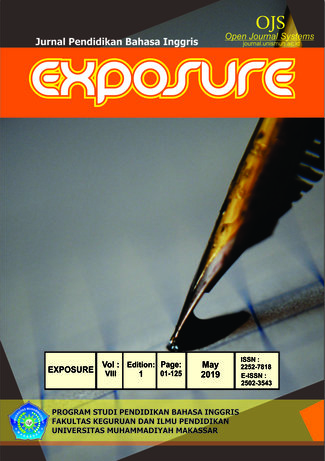THE EFFECTIVENESS OF USING GRAPHIC ORGANIZER CONCEPT ON STUDENTS’ READING SKILL
DOI:
https://doi.org/10.26618/exposure.v8i1.2086Kata Kunci:
graphic organizer concept, reading skill, effectivenessAbstrak
The aim of this research is to determine the effect of the implementation of the Graphic Organizer Concept on students’ reading skills. The method used for this study is Quasi Experimental Design with Pre-Experimental design type one-group pretest-posttest design. The total subject of this study is 15 of Primary Education Department second semester students. The Data collection techniques were carried out by tests. Test the validity of using Product Moment test while the reliability test uses Alpha, the data analysis technique uses the Kolmogorov-smirnov test with the help of the SPSS for windows program to test normality, and the t-test to test the hypothesis. Based on the research, there is an influence on the application of the Graphic Organizer Concept model, this is evidenced by the normality test results of data analysis obtained by the pretest significance of 0.134> 0.05 and the posttest significance of 0.118> 0.05. In the hypothesis test used the t-test, the results of the analysis of the t-test obtained t count (27,730)> t table (2,131). Because t count> t table then Ho is rejected and H1 is accepted. It means that graphic organizer concept affects the ability to read. The conclusion of this study is that the Graphic Organizer Concept learning model influences reading skills.Referensi
Burns,P.C.,Roe. B.D, and Ross, E.P. 1984. Teaching Reading in Today’s Elementary School (3rd ed), Chicago: Rand McNally College.
Carrel, P.L., Devine, J and Eskey, D.E.1988. Interaction Approach to Second Language reading. Cambridge: Cambridge University Press.
Bromley, K., DeVitis, L. I. and Modlo, M. (1995). Graphic Organizers: Visual Strategies for Active Learning. Nebw York: Scholastic Professional Books.
Celce, Murcia. 2001. Teaching English as a Second on Foreign Language. Washington: Heinle and Heinle Thomas Learning Inc.
Modlo, M. (1999). 50 Graphic Organizers for Reading, Writing & More. New York: Scholastic Professional Books.
Nunan, D. 2003. Practical English Language Teaching.Singapore: Mc grawHill
Patel, M.E., Jain, P,M. 2008. English Langauge Teaching (Methods, Tools & Techniques). Jaipur: Sunrise Publishers Distributors.
Richard, Jack C, and Theodore Rodgers.2001. Approaches and Methods in Language Teaching. Cambridge University Press
Sugiyono. (2015). Metode Penelitian Kombinasi (Mixed Methods). Bandung: Alvabeta,cv.
www.edb.gov.hk/attachment/en/curriculum-development
Unduhan
Diterbitkan
Terbitan
Bagian
Lisensi
Authors who publish with this journal agree to the following terms:
In order to assure the highest standards for published articles, a peer review policy is applied. In pursue of the compliance with academic standards, all parties involved in the publishing process (the authors, the editors and the editorial board and the reviewers) agree to meet the responsibilities stated below in accordance to the Journal publication ethics and malpractice statement.
Duties of Authors:
- The author(s) warrant that the submitted article is an original work, which has not been previously published, and that they have obtained an agreement from any co-author(s) prior to the manuscript’s submission;
- The author(s) should not submit articles describing essentially the same research to more than one journal;
- The authors(s) make certain that the manuscript meets the terms of the Manuscript Submission Guideline regarding appropriate academic citation and that no copyright infringement occurs;
- The authors(s) should inform the editors about any conflict of interests and report any errors they subsequently, discover in their manuscript.
Duties of Editors and the Editorial Board:
- The editors, together with the editorial board, are responsible for deciding upon the publication or rejection of the submitted manuscripts based only on their originality, significance, and relevance to the domains of the journal;
- The editors evaluate the manuscripts compliance with academic criteria, the domains of the journal and the guidelines;
- The editors must at all times respect the confidentiality of any information pertaining to the submitted manuscripts;
- The editors assign the review of each manuscript to two reviewers chosen according to their domains of expertise. The editors must take into account any conflict of interest reported by the authors and the reviewers.
- The editors must ensure that the comments and recommendations of the reviewers are sent to the author(s) in due time and that the manuscripts are returned to the editors, who take the final decision to publish them or not.
Authors are permitted and encouraged to post online a pre-publication manuscript (but not the Publisher’s final formatted PDF version of the Work) in institutional repositories or on their Websites prior to and during the submission process, as it can lead to productive exchanges, as well as earlier and greater citation of published work (see The Effect of Open Access). Any such posting made before acceptance and publication of the Work shall be updated upon publication to include a reference to the Publisher-assigned DOI (Digital Object Identifier) and a link to the online abstract for the final published Work in the Journal.

